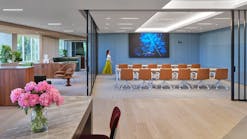COMMENTARY | A year-end reflection on lighting and LED innovations
The year's end always catches me off-guard. As the chill in the autumn air becomes biting, I think of the adage shared among parents: “The days are long, but the years are short.” You don’t need to be a caregiver to get that.
In January, I started at LEDs Magazine not knowing much beyond the fundamentals of light-emitting diodes and what I had retained from my second semester of college physics. From my past year of working on the brand and reading our coverage by subject matter experts, our tireless contributor Mark Halper, and our dedicated managing editor Carrie Meadows, I can’t help but ask, “What can LEDs not do?”
The ability to tune LEDs to wavelengths across the visible light spectrum lends their use in supporting everything from worker productivity and occupant amenities to resident sleep and health, controlled environment agriculture, community engagement, and energy efficiency. Meanwhile, ultraviolet LEDs have shown such promise in germicidal applications that the Illuminating Engineering Society formalized testing standards this year with ANSI. On the other end of the light spectrum, infrared LEDs are finding expanded uses beyond security cameras, imaging equipment, and the humble remote control to augmented and virtual reality technologies that track eye movement.
Lighting controls have also gained ground this year in luminaire-level electronics and smart and connected devices for building systems. The ability to control and monitor each fixture has attracted building owners and tenants seeking to enhance the occupant experience all the while optimizing their electricity use as the hybrid workplace persists.
Our carbon footprint has increasingly taken hold in the consciences of businesses within and beyond the lighting sector. Though some may point to LEDs’ inherent efficacy over conventional sources as their contribution to energy savings, other companies are becoming more proactive and creative. For example, several manufacturers have introduced fixtures that support the circular economy by using recyclable materials or replaceable parts that extend or repurpose fixture operation.
Many lighting designers and specifiers are also prioritizing the quality of light over the quantity. Yes, we can flood city streets with thousands of lumens around the clock under the guise of safety — but that doesn’t mean we should. And, yes, we can illuminate buildings, roads, and landscapes to accent, enhance, and exaggerate any feature desired. But our human, animal, insect, bird, and plant neighbors won’t appreciate disorienting, distracting, or omnipresent lumens, intentional or stray. This leads me to another development from this past year: the DesignLights Consortium’s LUNA Technical Requirements, which outlines product specifications that support energy efficiency, limit sky glow and light trespass, and maintain suitable nighttime visibility for people.
These are but some of this year’s industry developments and applications that have continued to advance LED technology and educate lighting professionals to wield their powers respectfully. As we enter 2023, I eagerly await where LEDs will head next.
WANDA LAU is editorial director of LEDs Magazine and Smart Buildings Technology. She previously served as executive editor of Architect magazine and worked for a decade in the architecture, engineering, and construction industry.
For up-to-the-minute LED and SSL updates, follow us on Twitter. You’ll find curated content and commentary, as well as information on industry events, webcasts, and surveys on our LinkedIn page and our Facebook page.

Wanda Lau | Editorial director, LEDs Magazine, Architectural SSL, and Smart Buildings Technology
Wanda Lau is an award-winning editor, writer, and podcaster whose work appears in several publications, including Architectural Lighting and Architect, where she was most recently the executive editor. In 2021, she was named one of Folio: and AdMonsters' Top Women in Media, in the DEI Champions category. Along with working a decade in the architecture, engineering, and construction industry, she holds a B.S. in civil engineering from Michigan State University, an S.M. in building technology from MIT, and an M.A. in journalism from Syracuse University.





